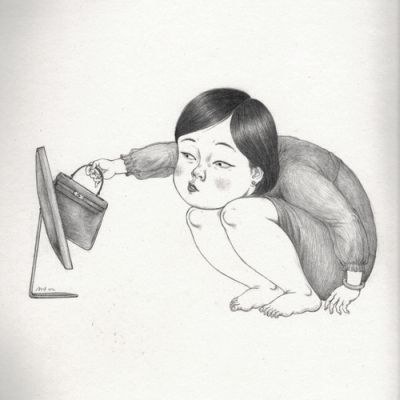
5 Minutes with… Fei Wang

It’s quite easy
to lose yourself in Fei Wang’s illustrations . At turns sweet, incisive and
fantastical, they’re inspired by everything from Indian miniatures to Japanese ukiyo-e
pictures. Head of Art and creative director at OgilvyOne Beijing, you’d expect
Fei to be artistically gifted but his love of art goes so much deeper- in 2011
he even took a year to step off the advertising treadmill to head to London’s
Camberwell College of Arts to refine his illustration skills even further. Now
he’s back in the Ogilvy fold, putting his talent to good use and also doing his
bit to bring Western artists and Chinese artists closer together with his Image
Makers exhibition. LBB’s Laura Swinton
caught up with him to find out more.
LBB> What is so unique about OgilvyOne Beijing right now?
FW>
When other agencies are fixated on the bottom-line to keep up in the dynamic
China market, we are laser-focused on maximizing our rich heritage of
creativity like never before. This year we have a new President of OgilvyOne
China, Jacco ter Schegget, who has been energizing us to create higher quality
work. This has built more enthusiasm as we have refocused on creativity, our
core.
LBB> And which recent OgilvyOne Beijing projects have particularly resonated with you and why?
FW> I was recently involved in a
campaign called “Words can be Weapons” to call attention to verbal child abuse
in China. My colleagues selected hurtful words and redesigned each Chinese
character to make them resemble weapons – conveying the message that words can
be turned into weapons. We also created an animation and website around the
idea to engage people to watch the documentaries and to ask for help from
psychologists. More than 300 calls were
made to the helpline within the first two weeks of the website’s launch.

The campaign was very well crafted.
It even went on to win two Lions at Cannes this year. But more importantly it
was meaningful for the target audience. I’m convinced that the world would be a
better place if we created and designed more work like this that have a
positive impact on society.
LBB> How did
you get into advertising in the first place?
FW>
I got into advertising by chance really! After graduating with a visual
communications degree from Singapore, I returned to China in pursuit of
becoming a graphic designer. A fellow designer referred me to OgilvyOne and my
advertising career took off from there.
LBB> You were a judge on the Design Jury at Cannes this year – what were the key debates happening in the jury room this year?
FW>
In the Design jury, we were constantly debating the judging criteria. Some
jurors focused on the entries’ craft and visual impact, while others looked for
a good balance between great design and a great idea to change consumer
behavior, creatively inspire our industry, or solve a social issue. I belonged
to the second camp of jurors.
I
remember one of the Japanese jurors who would say, “This is beautiful!” for
several entries. And actually appreciating the beauty isn’t superficial, but
simply pointing out the essence of the Design category. We are all visual
animals in the end. A “beautiful” visual is still highly valued.
LBB> And what was it about the Bergen International Festival work that made it deserving of the Grand Prix?
FW> Compared to the other Grand
Prix contenders, the Bergen work stands out because it is so truly abstract and
elegant. It’s an expandable design system that was ingeniously created based on
the nature of music. Not to mention that the design of the key elements was
dynamic and versatile enough to produce countless patterns across both
traditional and digital media.
LBB> A few years ago you went back to school to do an illustration MA at Camberwell – what was it like going back to university as someone established in their career and with experience of working professionally? What were the key things that you gained from that experience?
FW> It was like a super long
vacation! Not in the sense that it was killing time, but I actually found the
time to do the things I loved but couldn’t make time for before. It was also a
great opportunity to look back at what I have accomplished in the past seven
years and look forward to what’s next.
Etching was by the far the most fascinating out of everything I did on this MA course. In fact I ended up completing my entire final project through etching on copper plate. It was also such great fun to play around with a Victorian Press and dust mask! I had met so many talented illustrators from around the world, who I credit to broadening my perspective in art.

The Middle Kingdom, 1949
LBB> Looking
at the illustrations on your blog, they have a resemblance with Chinese
cartoons from the 1920s and 1930s while commenting on modern advertising ideas
like data, online shopping, sports marketing. Can you tell us about your own
personal projects – what themes and influences particularly interest you?
FW> I love observing children and their penchant for imitating adult behavior. I try to construct stories around children that parody adulthood. Not to be too cynical, but my belief is that our society has gotten too complicated, with conflicting politics, religions and economies. But these are all just games and toys for adults.

Online Luxury Shopping
My illustration style is inspired
by Japanese ukiyo-e, Indian miniature
paintings and classic Chinese ink paintings – pretty much a blend of East Asia.
Over the years, my work has evolved into a look that is unique and classy, but
doesn’t feel antiquated.

Future CIO
LBB> Chinese
advertising has been getting a lot more recognition on the global level over
the last few years but I’ve read that you feel art direction in China still has
some catching up to do. Why do you think this is and what are the keys to
developing it?
FW>
Chinese advertising has certainly been getting more global recognition, but
many pieces are recognized for their ideas and not their execution. Advertising
is a reflection of society, and as China is still in development, so too is its
advertising industry. Advertising professionals, brand marketers and visual
communication schools are in this development too.
LBB> Last year you curated the ‘Image Makers’ exhibition in which European illustrators were selected to make work specifically for the Chinese creative industries – what was your motivation behind getting involved in the project?
FW> My goal is to help my fellow
Chinese illustrators develop their own distinct, personal style with a
commercial aesthetic that is world-class. The ‘Image Makers’ exhibition brought
together different styles and perspectives to open minds to new possibilities.
LBB>Who are your creative heroes and why?
FW> I’d say Paul Rand. His
designs for IBM not only changed the image of this huge corporation, but also
its culture and history. Even 50 years later today, this brand is still
‘speaking’ in Rand’s unique, visual language.
LBB> Outside of advertising, what are your passions?
FW>
I love drawing. It’s the most simple, basic, yet charming way to communicate
and tell a story. I’m also a huge fan of collecting original Japanese ukiyo-e. Thanks to my wife, who’s an art
specialist, I have been able to acquire some great finds.
Check out more of Fei's awesome illustration at: http://feiwang80.tumblr.com/










